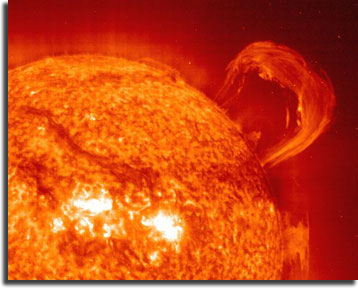 |
Our Sun
The sun, located at the center of our solar system, is the source of all life on planet earth. It effects every day life in more ways than one can imagine. It is by far, the largest untapped natural resource when it comes to the production of renewable energy, yet it is the most abundant form of energy available to us. The sun is located approximately 93 million miles from Earth, which means it takes light around 8 minutes on average to reach the earth from the sun (traveling at 670,616,629 miles per hour!). The sun is so large, it could fit 109 Earths inside of it.
What is the Sun is Made Of?
The sun is a gigantic nuclear fusion reactor, constantly creating helium by fusing together hydrogen atoms under the extreme temperatures and pressures of its core. These two elements make up 98% of its mass, with other heavier elements making up the remaining 2%.
How Does The Sun Create Energy and Light?
When two hydrogen atoms are fused together into helium, the helium atom contains less mass than the combined mass of the original two hydrogen atoms. This excess mass is converted to pure energy during the fusion reaction according to Einstein's famous E=MC^2 equation (Energy equals mass times the speed of light squared). Since the speed of light is an enormous number, this equates to a tremendous amount of energy released. This energy reaches earth in different forms, specifically particle radiation and different wavelengths of electromagnetic radiation.
What is the Temperature of the Sun?
The surface of the sun is a cool 11,000°F (6,000°C). It is the center of the sun where temperatures reach 27,000,000°F (15,000,000°C). In combination with the extreme pressure, these temperatures cause fusion of the hydrogen atoms.
What is a Solar Storm? 
A solar storm, also known as a solar flare (shown to the right), is an eruption of energy from the sun, out into space. Every 11 years, the sun reverses its magnetic field. When this reversal takes place, it is known as solar maximum. It is during this phase that solar flares are more likely to occur. A solar flare comprises of a large number of high energy particles moving at extremely high speeds. The Earth is constantly bombarded with these particles from the sun, but our magnetic field generally protects us from them. During a solar flare, the number of particles that are hurled in our direction, compress our magnetic field upon impact. Changing magnetic fields induce currents in electrical conductors, and in our case, our electric grid and satellites. A giant solar flare could potentially wipe out our entire electrical infrastructure in one shot, by destroying transformers and electrical circuits in every electronic device we own. This occurred on a limited basis in 1859 when electricity was first being used for communication over telegraph wires. With our complete and total dependence on electricity today, a large solar storm could have devastating consequences, knocking power out for months, or even years.